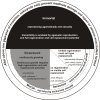Principles of alternative gerontology
- PMID: 27017907
- PMCID: PMC4925816
- DOI: 10.18632/aging.100931
Principles of alternative gerontology
Abstract
Surveys of taxonomic groups of animals have shown that contrary to the opinion of most gerontologists aging is not a genuine trait. The process of aging is not universal and its mechanisms have not been widely conserved among species. All life forms are subject to extrinsic and intrinsic destructive forces. Destructive effects of stochastic events are visible only when allowed by the specific life program of an organism. Effective life programs of immortality and high longevity eliminate the impact of unavoidable damage. Organisms that are capable of agametic reproduction are biologically immortal. Mortality of an organism is clearly associated with terminal specialisation in sexual reproduction. The longevity phenotype that is not accompanied by symptoms of senescence has been observed in those groups of animals that continue to increase their body size after reaching sexual maturity. This is the result of enormous regeneration abilities of both of the above-mentioned groups. Senescence is observed when: (i) an organism by principle switches off the expression of existing growth and regeneration programs, as in the case of imago formation in insect development; (ii) particular programs of growth and regeneration of progenitors are irreversibly lost, either partially or in their entirety, in mammals and birds.
Keywords: aging; energy; growth; life program; longevity; regeneration; senescence.
Conflict of interest statement
The authors declare that they have no conflict of interest.
Figures


Similar articles
-
The budding yeast Saccharomyces cerevisiae as a model organism: possible implications for gerontological studies.Biogerontology. 2017 Aug;18(4):631-640. doi: 10.1007/s10522-017-9712-x. Epub 2017 Jun 1. Biogerontology. 2017. PMID: 28573416 Free PMC article. Review.
-
Novel modulators of senescence, aging, and longevity: Small non-coding RNAs enter the stage.Exp Gerontol. 2010 Apr;45(4):302-11. doi: 10.1016/j.exger.2010.01.007. Epub 2010 Jan 18. Exp Gerontol. 2010. PMID: 20080172 Review.
-
[A.A. Malinovskiĭ and significance of the system approach in gerontology].Adv Gerontol. 2001;8:22-6. Adv Gerontol. 2001. PMID: 11582751 Russian.
-
How the analysis of genetic mutations can help us to solve basic problems in gerontology? I. Life extending genetic modifications in round worm C. elegans.Adv Gerontol. 2003;11:34-42. Adv Gerontol. 2003. PMID: 12820519
-
[Results and perspectives of cytogerontologic studies in modern time].Tsitologiia. 2002;44(12):1143-8. Tsitologiia. 2002. PMID: 12683324 Review. Russian.
Cited by
-
A Tale of Two Concepts: Harmonizing the Free Radical and Antagonistic Pleiotropy Theories of Aging.Antioxid Redox Signal. 2018 Oct 1;29(10):1003-1017. doi: 10.1089/ars.2017.7105. Epub 2017 Oct 17. Antioxid Redox Signal. 2018. PMID: 28874059 Free PMC article. Review.
-
Convergent adaptation of cellular machineries in the evolution of large body masses and long life spans.Biogerontology. 2017 Aug;18(4):485-497. doi: 10.1007/s10522-017-9713-9. Epub 2017 Jun 1. Biogerontology. 2017. PMID: 28573417 Free PMC article. Review.
-
The budding yeast Saccharomyces cerevisiae as a model organism: possible implications for gerontological studies.Biogerontology. 2017 Aug;18(4):631-640. doi: 10.1007/s10522-017-9712-x. Epub 2017 Jun 1. Biogerontology. 2017. PMID: 28573416 Free PMC article. Review.
-
Senescence as a trade-off between successful land colonisation and longevity: critical review and analysis of a hypothesis.PeerJ. 2021 Nov 2;9:e12286. doi: 10.7717/peerj.12286. eCollection 2021. PeerJ. 2021. PMID: 34760360 Free PMC article.
References
Publication types
MeSH terms
LinkOut - more resources
Full Text Sources
Other Literature Sources
Medical

